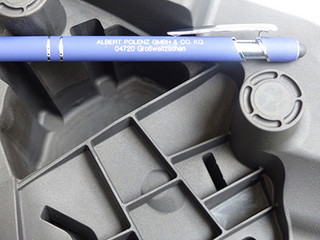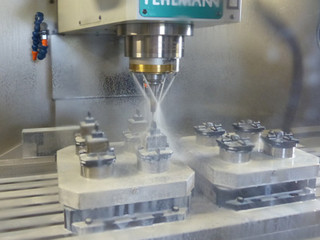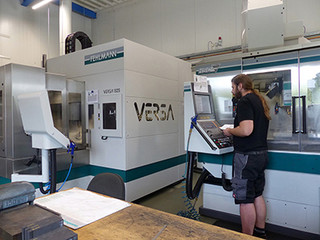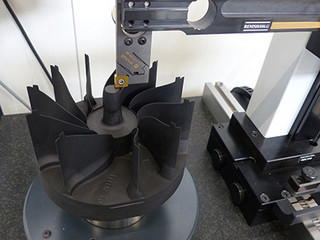Reliable wet-milling graphite in a new dimension
Albert Polenz GmbH & Co. KG - At Albert Polenz, toolmakers, the era of graphite machining already began in 2006. Meanwhile, the proportion of graphite electrodes is 100 percent. Despite suction directly at the workpiece and special scrapers for ball screws and guides, a solution to completely eliminate dust formation was searched for in Großweitzschen. Together with Fehlmann, a concept for wet machining graphite was developed. However, run times and material removal rates for graphite electrodes cannot be compared with those of conventional electrodes.
Cleanliness, flexible machine usage, high dimensional accuracy and low tool wear is what some machine and toolmakers promise when wet machining graphite. This may be true. However, as Albert Polenz already started using graphite electrodes in 2006, they have meanwhile reached dimensions that are beyond conventional machining: Ribs, honeycomb structures, run times per electrode, four to six pieces, 30 to 40 hours, sometimes even up to 60 hours. With corresponding material removal rates. However, this amount of graphite wet machining requires corresponding machining centers. At least that is how managing director Andreas Voigt sees it: "Up to now, with the suction at the workpiece, our graphite machining was never particularly dirty. However, we still had problems because graphite, with its high "creeping" abilities, was constantly in the air. That is why we were looking for a suitable machine or solution. However, most of the concepts currently available on the market were not acceptable for us and were mostly designed for mixed operation. With the volumes we produce, we would have been spending most of our time cleaning. These systems usually work with skimmers or cartridge systems, but they are only designed for a wide range of applications, not for intensive use. "So we tested and tested in Großweitzschen. The project failed again and again due to the filter systems, until Andreas Voigt remembered that Fehlmann's machines, process glass and ceramics, among other materials. After initial discussions with the responsibles at Fehlmann, the decision was made to look for a solution to this challenge together. This project that was risky for both Albert Polenz and Fehlmann. On the one hand, in the past attempts to wet-mill graphite have generally failed. On the other hand, Fehlmann took on the responsibility as the general contractor, even though they could not simulate Polenz's three-shift graphite machining operation. Specifically, the task was to seal the nozzles, guides, ball screws, etc. with a corresponding abrasive package and adjust the suction and/or filter systems.
The challenge: The material removal rates in a three-shift operation
Although Andreas Voigt and Roland Sandmeier, Sales Manager for Fehlmann in Germany, were initially sceptical, Andreas Voigt decided to convert the entire graphite division to wet milling immediately after completion of the first task using a 5-axis VERSA 825 machine. Both the VERSA 825, which was selected because of the height of the electrodes, and the Fehlmann PICOMAX 90 had to be reconfigured. As Roland Sandmeier points out: “The sealing of guides, ball screws, etc. was not new to us, having worked with the glass and ceramic processing machines, and we adjusted the suction accordingly. We were also familiar with the manufacturer of the filter systems. But the material removal rates in a three-shift operation were a challenge. As a machine manufacturer, we can not carry out endurance tests. An efficient solution was to fit the filter system with two centrifuges, so that one centrifuge can be cleaned while the machine is running.” Specifically, the coolant is pre-filtered and then passed through a band filter and into the centrifugal force filter. The plan to wet-mill graphite, therefore, seems to have been successful in Grossweitzschen. The machines have been in operation for just under one year and - as Roland Sandmeier says - still looks as good as new. Andreas Voigt thinks that this experiment has been successful in several ways. “First of all, graphite has evolved. There are now many types of graphite which are considerably denser and have smaller grain sizes than in the past. There is no real risk of coolant entering the electrodes. Another point is the fact that, unlike other machine manufacturers, Fehlmann was prepared to support us in our mission.”
In the meantime, both Fehlmann machines are being used to capacity with graphite. The precision that Polenz expectes from Fehlmann is guaranteed.
Polenz at a glance
With the development of plastics in the late 1920s, the company started out manufacturing tools for the processing of thermosetting plastics, and later thermoplastics. Today, the company has 36 employees and 2 apprentices. The production spectrum includes tools for making moulds with dimensions of up to 900 mm x 600 mm (7,000 kg), cutting tools measuring 500 mm x 1,000 mm, and tools with hot-runner injection moulding, split moulds, slide moulds, multi-plate tools, unscrewing moulds, tools with free-form surfaces according to 3-D data sets, thermosetting pressing and injection moulding tools, and cutting, bending and progressive tools.
The company’s client base stems from a wide variety of industries. The automotive, electrical/electronics and consumer goods industries are key customers in the injection moulding tools market. Meanwhile, the automotive and electrical industries and the medical technology sector can rely on Polenz for cutting and bending tools.
Interesting to note
In recent years, Albert Polenz GmbH, at the former location in Döbeln, was surprised by water and mud masses that caused total losses. Therefore, about three million euros were invested and production started at the new location in 2015 in Großweitzschen.
By the way
The 5-axis machining center VERSA 825 is connected to a workpiece robot, while the PICOMAX 90 is designed as a three-axis machine and for workpiece handling with UPC pallets. Both machines are usually machining to capacity in a three-shift operation.
Contact
Albert Polenz GmbH & Co. KG
Mr. Andreas Voigt
D-04720 Großweitzschen
Tel. +49 3431/608417-0
www.polenz-doebeln.de




